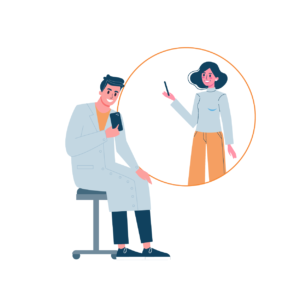COVID-19 was originally referred to simply as the “Coronavirus”. It is important to note that there are many Coronaviruses, including SARS, that affect humans and have caused endemics or even pandemics in the past. Avoiding a pandemic of the virus is only possible by first understanding its origin, signs, and overall viral structure. The rise in concern for Corona is due to its newness, as this particular strain (19) has never been identified in human beings prior to December of 2019. The virus strain itself is said to have originated from other animals, including bats, although this is still under investigation.
The respiratory illness itself causes symptoms that may be confused for a traditional cold and the common flu.
The most common signs of the strain include:
- Shortness of breath
- Ongoing cough
- Fever

While many of these symptoms are prevalent in standard colds and flu strains, it is important to consider whether or not you may have been exposed to another individual who may be carrying the virus themselves when seeking medical attention.
How Does COVID-19 Spread?
According to the CDC, it has the potential to spread via person-to-person and even by contact with infected surfaces. Person-to-person infections occur when an individual who is carrying the virus (with or without presenting symptoms) coughs, sneezes, or breathes near another individual, expelling droplets that contain the virus itself.

Unfortunately, because this strain of Corona is new and still under investigation by multiple health organizations, there is no clear and definitive incubation period set for the virus. Some organizations such as the CDC claim that the incubation period of COVID-19 may be anywhere between 2 and 14 days, which is not a short window of time for those going about their business, attending work, and spending time around others unknowingly carrying and spreading the virus.
Criteria to Guide Evaluation of Persons Under Investigation (PUI) for COVID-19
Understanding the criteria to guide the evaluation of persons under investigation (PUI) for Corona is essential in all workplaces, communities, and even in households. Determining and identifying potential carriers of Corona can help minimize or eliminate the risk of spreading the virus even more with proper medical care, follow-ups, and quarantines as necessary. Healthcare leadership and practice management professionals should utilize this procedure in diagnosing new patients who are presenting with symptoms that align with the symptoms of COVID-19.

In order for concern, patients must exhibit both clinical symptoms as well as an epidemiologic risk. According to the CDC, there are ways to determine the overall risk of carrying the virus for medical professionals and testing facilities.
— If a patient is presenting with fever or cough/shortness of breath, they must also confirm that they may have had contact with an individual, including healthcare workers, who may have also come into contact with the virus.
— For patients who present with fever in addition to shortness of breath and coughing may have a greater risk of carrying the virus if they have visited Wuhan, Hubei Province, China, within the past 14 days.
— Individuals who present with fever, cough, shortness of breath, and require hospitalization, have a much greater risk of carrying the virus if they have visited China’s mainland in the past 14 days.

Due to the extended 14-day incubation period, diagnosing, monitoring, and tracking the spread of this Coronavirus strain has become increasingly difficult and challenging, especially without an antibiotic or treatment widely available for patients.
Is your facility ready for COVID-19?
AB Med Healthcare Solutions, can help your facility to develop and implement a preparedness plan that is specific to your needs. Alleviate stress and fears while ensuring a safe working environment for your staff and a quality healthcare delivery for your community.
Are you looking for a way to better prepare your facility as well as the staff you employ for the potential spread of the COVID-19 virus? At AB Med Healthcare Solutions, we specialize in developing emergency preparedness solutions for both urban and rural medical and health facilitie
If you want to create a COVID-19 preparedness plan that is reassuring, accurate, and effective, contact AB Med today. Our experts are here to help!
The AB Med team is here for your facility and your community. We have the knowledge and experience to help you navigate through the challenges into a successful emergency plan. Let’s Connect.
COVID-19 Disclaimer
At AB Med, accuracy is our highest priority, and everything we publish is up-to-date based on research and news at the time of release. However, due to the continually evolving nature of COVID-19, we are aware that available data changes quickly. The available data and recommendations may have changed since this article’s publication. Please check the CDC, WHO, and your local health department for the most current recommendations and news.
We at AB Med are excited to talk to you, Contact us
REFERENCES & RESOURCES
- Coronavirus Disease 2019, 2020, CDC, Center for Disease Control and Prevention https://www.cdc.gov/coronavirus/2019-ncov/index.html
- Coronavirus Disease 2019, 2020, DHEC https://www.dhec.sc.gov/index.php/health/infectious-diseases/viruses/coronavirus-disease-2019-covid-19
- Coronavirus Disease 2019, 2020, Texas Department of State Health Services https://dshs.texas.gov/coronavirus/
- COVID-19 Fact Sheet, 2020, Ohio Department of Health https://odh.ohio.gov/wps/portal/gov/odh/know-our-programs/novel-coronavirus/resources/novel-coronavirus-fact-sheet
- Evaluating and Reporting Persons Under Investigation (PUI), 2020, CDC, Center for Disease Control and Prevention https://www.cdc.gov/coronavirus/2019-ncov/hcp/clinical-criteria.html?CDC_AA_refVal=https%3A%2F%2Fwww.cdc.gov%2Fcoronavirus%2F2019-ncov%2Fclinical-criteria.html
By: Erik McLaughlin MD, MPH and Aikaterini Papadopoulou, B.Arch








